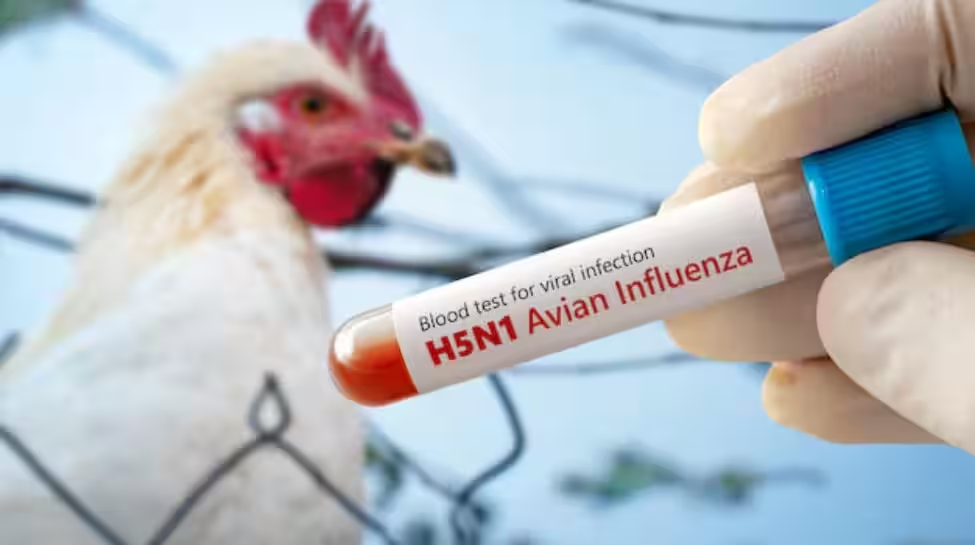H5N1 Bird Flu: What you need to know about its spread and human risks
H5N1 or bird flu symptoms include high fever, cough, sore throat and muscle aches
By Anoushka Caroline Williams
Bird Flu: H5N1 has caused concern as an infected human died in USA, CDC reported leading to an alert in all poultry units worldwide
Hyderabad: The H5N1 virus, a type of avian influenza (commonly called bird flu), has drawn global attention due to its highly infectious spread among birds and its potential to infect mammals, including humans. With the recent death of a person in the United States from the virus marking a critical development, health experts are urging awareness and preventive measures.
H5N1 has been responsible for widespread outbreaks in poultry and wild birds, causing significant losses in the animal population. Experts warn that although human-to-human transmission has not yet occurred, the virus remains a concern because of its ability to evolve rapidly.
What is H5N1?
H5N1 belongs to the family of influenza viruses that primarily infect birds. Ever since it was first identified in 1996 in Guangdong, China, the virus has caused sporadic outbreaks among humans too, mostly due to direct contact with infected birds or contaminated environments.
Dr Shastri Kumar, a virologist in Hyderabad, explained, “H5N1 is primarily an animal virus, but it has demonstrated the ability to infect humans under specific circumstances. The virus is highly pathogenic and its spread among birds has been a persistent global issue.”
How does H5N1 spread to humans?
Most human cases have been linked to direct or indirect contact with infected birds, their droppings or contaminated environments, such as live bird markets. Some cases of transmission from infected mammals to humans have also been documented.
“There is no evidence yet of sustained human-to-human transmission,” said Dr Aditi Sharma, an infectious disease specialist. “However, the possibility of genetic adaptations that could make the virus transmissible between humans is a serious concern.”
Symptoms in humans include high fever, cough, conjunctivitis etc.
The symptoms of H5N1 infection can range from mild to severe. Common symptoms include high fever, cough, sore throat and muscle aches. Non-respiratory symptoms such as conjunctivitis and neurological changes like seizures have also been reported.
“The progression of the disease can be rapid in severe cases, often leading to respiratory failure,” noted Dr Kumar. “Timely diagnosis and treatment are critical in preventing complications and fatalities.”
Why is H5N1 a concern?
The primary concern with H5N1 lies in its potential to evolve into a form that spreads easily between humans, triggering a global influenza pandemic. Historical pandemics, like the 1918 H1N1 outbreak, underscored the potential severity of such a scenario.
Dr Sharma elaborated, “The human population has very low immunity to H5N1 due to limited prior exposure. If the virus adapts genetically to transmit efficiently among humans, it could overwhelm healthcare systems worldwide.”
While human infections remain rare, the high fatality rate—over 50 per cent of reported cases—adds to the concern.
Is It safe to consume poultry and eggs?
Health authorities said that properly cooked poultry and eggs are safe to consume. However, raw or undercooked meat and eggs from infected areas should be avoided.
“Cooking meat and eggs thoroughly kills the virus,” said Dr Nandita Rao, a nutritionist based in Hyderabad. “However, people in areas with outbreaks should avoid handling sick or dead birds and ensure proper hygiene when dealing with poultry products.”
How is H5N1 treated?
Antiviral medications, such as oseltamivir, are the primary treatment for H5N1 infections. Early administration is crucial for effective outcomes.
“Patients showing severe symptoms or those at a higher risk of complications should start antiviral treatment immediately,” advised Dr Kumar. “Supportive care, such as oxygen therapy, may also be necessary in severe cases.”
Preventive measures and vaccines
Currently, there is no widely recommended vaccine for H5N1.
However, some countries have developed vaccines for pandemic preparedness. The World Health Organization (WHO) has agreements with vaccine manufacturers to rapidly produce and distribute vaccines in the event of a pandemic.
“In India, the focus should be on strengthening surveillance and improving public awareness,” said Dr Sharma. “People working with poultry must wear protective equipment and maintain hygiene to minimise risk.”
What can we do to stop H5N1 future spread and infection?
As the virus continues to evolve and spread, experts urge governments and public health organisations to prioritise monitoring and research. The global rise in outbreaks among mammals, alongside persistent bird infections, highlighted the urgency of pre-emptive action.
“The H5N1 virus serves as a reminder of the zoonotic threats we face,” said Dr Kumar. “Strong international cooperation, early detection and public awareness are the key tools to prevent this virus from becoming a larger public health crisis.”
While the immediate risk of an H5N1 pandemic remains low, experts caution that vigilance is essential to mitigate potential risks.